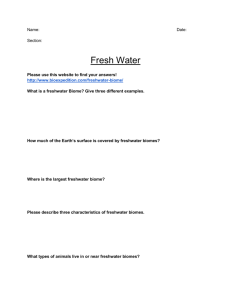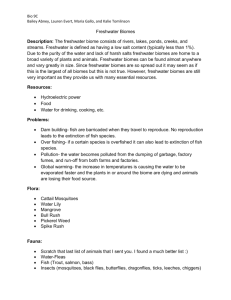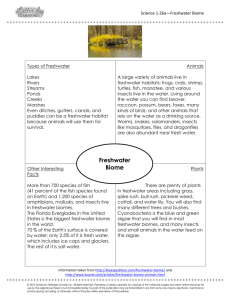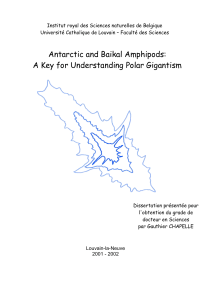PLANET EARTH: FRESHWATER DVD http://dsc.discovery.com
advertisement
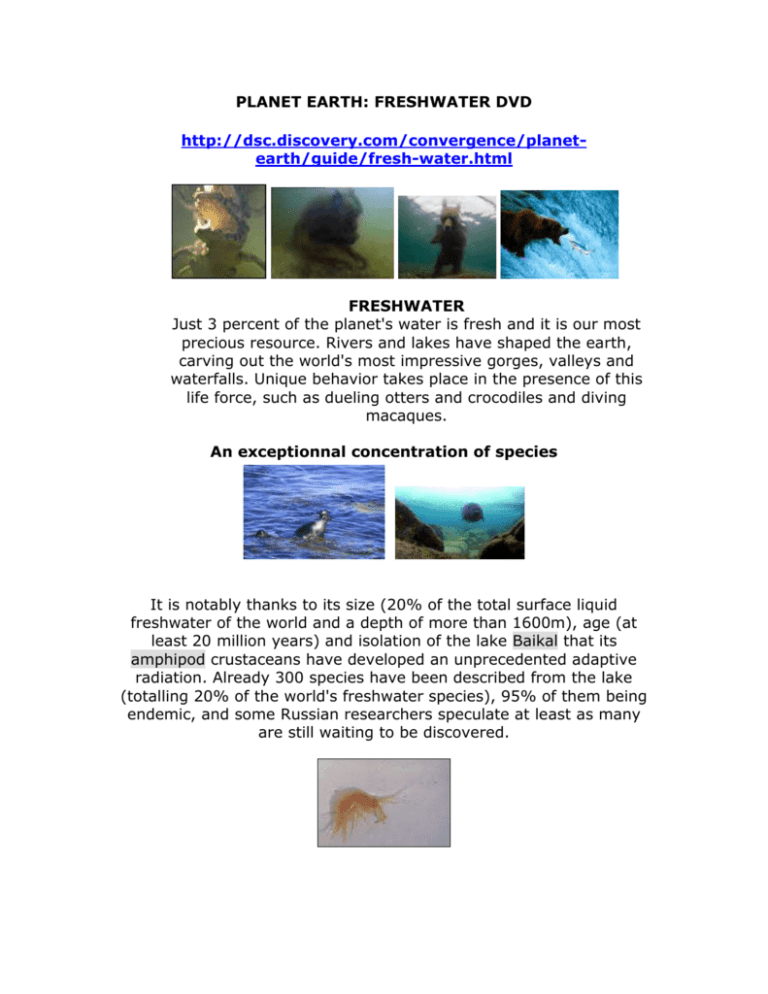
PLANET EARTH: FRESHWATER DVD http://dsc.discovery.com/convergence/planetearth/guide/fresh-water.html FRESHWATER Just 3 percent of the planet's water is fresh and it is our most precious resource. Rivers and lakes have shaped the earth, carving out the world's most impressive gorges, valleys and waterfalls. Unique behavior takes place in the presence of this life force, such as dueling otters and crocodiles and diving macaques. An exceptionnal concentration of species It is notably thanks to its size (20% of the total surface liquid freshwater of the world and a depth of more than 1600m), age (at least 20 million years) and isolation of the lake Baikal that its amphipod crustaceans have developed an unprecedented adaptive radiation. Already 300 species have been described from the lake (totalling 20% of the world's freshwater species), 95% of them being endemic, and some Russian researchers speculate at least as many are still waiting to be discovered. As their name suggest, the Abyssogammarus (60mm) species are limited to the deepest parts of the lake (never shallower than 300m). Macrohectopus branicki, an aberrant planktonic species, is the ecologic equivalent of the antarctic krill. Its huge swarms constitute more than 90% of the amphipod biomass of the lake, and are the primary food resource of several fishes of economic importance. The key to polar gigantism Moreover, Baikal amphipods are characterised by the world's most extensive size range. The adult size of these animals varies from 2 to 90 mm (compare with the maximum size of 37 mm of the Bitish species). The study of these organisms carried out at the Royal Belgian institute of Natural Sciences has resulted in a new hypothesis explaining polar gigantism, according to which the amount of dissolved oxygen determines the maximum potential size of these animals. Pallasea cancellus is a big opportunistic species (50mm). It adapts remarkably to captivity (more than 3 years at the RBINS). The wonderful Acanthogammarus maximus (65mm) belongs to the same genus than the biggest species both for the lake and the world freshwater, measuring 90mm. It lives in shallow water. A rich collection Two sucessive expeditions (1995; 1996) to lake Baikal have yielded more than 100 species belonging to 25 genera, ranking the Royal Belgian Institute of Natural Sciences' collections amongst the richest in the world, particularly with respect to the biggest species. It is also at our Institute that a handful of species have been studied in captivity, for the first time outside the ex-USSR. Ommatogammarus albinus, which can be sampled by thousands with baited traps up to the greatest depths of the lake show a staggering ecological convergence with the numerous necrophagous species of a marine amphipod superfamily, the lysianassoids. http://www.youtube.com/watch?v=I9KXRHk3AkU http://k43.pbase.com/g6/45/743145/2/73366732.mBjXAKBU.jpg http://fish.picturesargentina.com.ar/dorado.jpg http://bugguide.net/node/view/14955 http://www.ucmp.berkeley.edu/exhibits/biomes/freshwater.p hp http://www.buzzle.com/articles/fresh-water-biomes.html http://www.mbgnet.net/fresh/ http://www.worldbiomes.com/biomes_aquatic2.htm http://www.aurumscience.com/environmental/4_ecosystems /earth_freshwater.html http://dsc.discovery.com/convergence/planetearth/guide/fresh-water.html http://www.ucmp.berkeley.edu/exhibits/biomes/freshwater.p hp http://www.buzzle.com/articles/fresh-water-biomes.html http://www.mbgnet.net/fresh/ http://www.worldbiomes.com/biomes_aquatic2.htm http://www.aurumscience.com/environmental/4_ecosystems /earth_freshwater.html http://dsc.discovery.com/convergence/planetearth/guide/fresh-water.html http://reaganess.weebly.com/uploads/2/7/5/6/2756971/fre shwater.pdf

